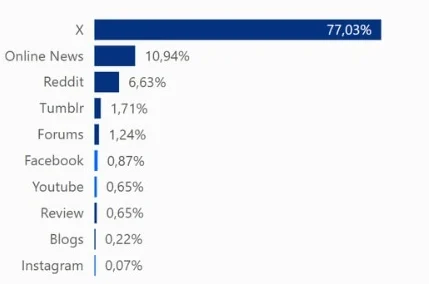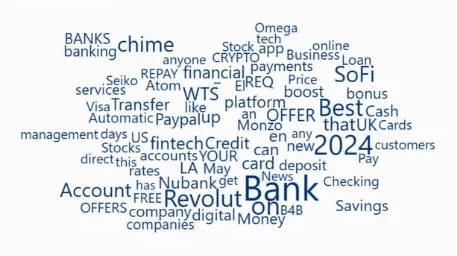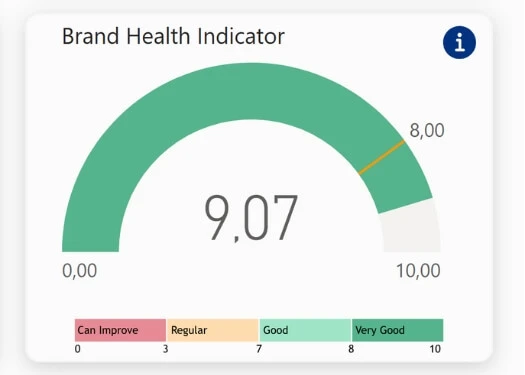The digital banking industry is extremely competitive and knowing how the public perceives a brand is one of the main steps for staying relevant. This is where Central Brand Insights (CBI) comes into play.
CBI is a powerful tool that collects and analyzes conversations across social media and other platforms, providing valuable brand insights. But what exactly do these data reveal about the popularity of a digital bank? Let’s break down these components in an accessible way and explore why they are so important.
Measuring Popularity in the Digital Banking Industry: Total Mentions and Unique Authors
Imagine you’re at a large party where people are discussing various digital banks. Total mentions would be like counting how many times each bank’s name is brought up during the event.
This figure gives a clear indication of how much a bank is trending in conversations. However, knowing the number of times a bank is mentioned isn’t enough. This is where unique authors come in—essentially how many different people are talking about that bank. The more unique authors the broader and more diverse the discussion signaling a wider interest in the bank.
Who’s Listening? Estimated Reach and Impressions
Now consider how many people might have overheard these conversations at the party. That’s your estimated reach—the potential number of people exposed to discussions about a digital bank.
This is important because it shows the potential impact these conversations can have. On the other hand impressions tell us how often these mentions were seen. If reach is the number of people in a room, impressions are like the number of times the bank’s name was repeated to them. A high number of impressions suggests that people are consistently exposed to the content, which can reinforce brand recall and familiarity.
Who’s Winning the Race? Understanding Share of Voice (SOV)
With a general understanding of the landscape, the question arises: which bank dominates the conversation?
This is where Share of Voice (SOV) comes into play—a metric that shows what portion of the conversation a particular digital bank holds compared to all others.
Here’s how you can easily calculate the Share of Voice:
- Take the number of mentions for a specific bank;
- Divide it by the total mentions of all digital banks;
- Multiply by 100;
The result is a percentage that indicates how relevant that bank is relative to its competitors.
For example, if a digital bank has 500 mentions and the total mentions for all digital banks is 2,000, the SOV would be 25%. This means that this digital bank is responsible for a quarter of all conversations about digital banks, indicating a strong and significant market presence.
Channel Distribution: Where Are the Conversations Happening?
Beyond knowing how much a bank is being talked about, it’s essential to understand where these conversations are taking place.
CBI shows the percentage of mentions by channel, revealing which platforms—like Facebook, Twitter or Instagram—are most popular for these discussions. With this information, digital banks can fine-tune their marketing strategies to focus on the platforms where their audience is most active.


Word Clouds and Sentiment Analysis: Delving Into the Content
To grasp the content of the conversations, CBI uses word clouds—a visual tool that highlights the most frequently mentioned words surrounding a bank. The bigger the word in the cloud, the more often it was used. This quick visualization helps identify key themes, concerns, or praises from consumers.


More importantly, CBI analyzes the sentiment behind these mentions, classifying them as positive, neutral, or negative. This aspect is crucial because it’s not enough to know that people are talking about a bank—you need to understand how they feel about it. A brand might be mentioned frequently, but if most mentions are negative, it could signal a reputational issue that needs to be addressed.
Uncover Your Brand’s Potential: The Brand Health Indicator (BHI) That Measures What Matters
A Brand Health Indicator (BHI) is a comprehensive metric that evaluates the overall perception and strength of a brand in the market. It combines various factors such as customer sentiment, brand awareness, and engagement across social media platforms and other consumer touchpoints. By tracking positive, neutral, and negative mentions, the BHI provides a clear picture of how the public views a brand.
Understanding a brand’s health is crucial because it helps companies identify strengths and weaknesses, manage brand reputation, and make informed decisions about marketing strategies. A healthy brand often leads to higher customer loyalty, better market positioning, and increased business success. Without monitoring brand health, a company risks falling behind competitors or missing early warning signs of reputational damage.
A higher BHI score indicates a more positive and healthier brand image. Imagine a digital bank has 305 total mentions 208 of which are positive or neutral. Dividing 208 by 305 and multiplying by 100 gives a percentage of 68.2%. This percentage is then adjusted to a 0 to 10 scale resulting in a score of 6.8—indicating a positive perception but with room for improvement.


The Power of Data in Decision-Making
Making decisions based on relevant data takes the guesswork out of the process, leading to more accurate predictions, better resource allocation, and a competitive edge in the market. In today’s digital age, leveraging data is no longer optional—it’s essential for staying ahead and thriving in any industry.
CBI for digital banks offers a rich and detailed way to understand how they are perceived by the public.
By combining quantitative metrics like total mentions, estimated reach and SOV with qualitative analyses such as sentiment and BHI it’s possible to gain a full and strategic view of a digital bank’s market presence. With these insights digital banks can adjust their communication strategies, enhance their image and strengthen their position in the competitive digital financial market.
Learn more about our solution here!
Enjoying our content? Sign up for our newsletter and be the first to receive our latest articles. Stay informed on data analytics insights, business intelligence trends, marketing strategies, and the latest advancements in artificial intelligence.


